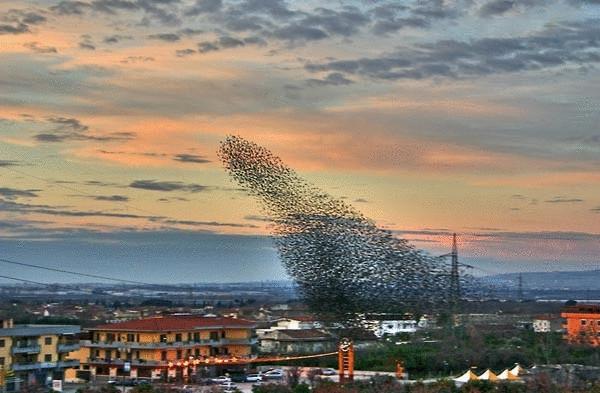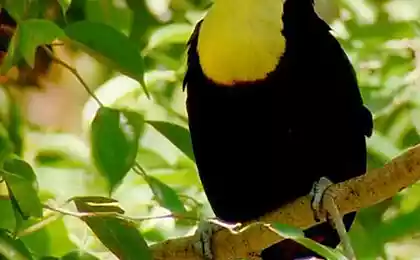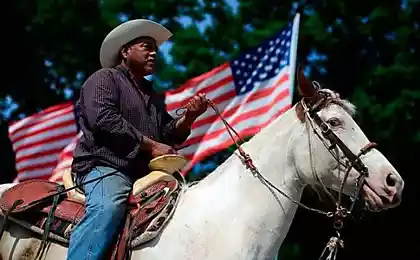610
The electromagnetic noise interferes with birds to navigate
In urban environments birds can't quite trust their system of geomagnetic navigation – its work is hampered by many sources of artificial electromagnetic fields.
It is believed that for spatial orientation in birds there is a whole Arsenal of "compasses", and zoologists still continue to learn something new about how these "compasses" work. So, literally last year Hagstrum Jonathan (Jonathan T. Hagstrum) of the USGS suggested (backed by experimental data) that the important role in the ability of birds to navigate play infrasonic waves.
And wave these in turn depend on the topographical and climatic characteristics of a particular territory, that is, it turns out, birds have in mind is something like infrasound maps.

On the other hand, in the same 2013 researchers from the Institute of ornithology of the max Planck Society announced that the birds are still and sapagovas card that they literally can sniff out the correct route.
Well, the eyes of birds, too, do not remain: ornithologists from Oxford found that the more complex a landscape characterized by a bird is better than the monotonous countryside. That is, in the open field, in the city or in the woods some pigeons to navigate more complicated than where the hills, trees, rivers and flat areas alternate with each other.
However, most zoologists intrigued by the geomagnetic sense of birds. For decades scientists have tried to figure out how this sense in birds works, in the end everyone agreed that without the Earth's magnetic field birds can not do, but what they feel this field remains incomprehensible.
On this subject, being heated debate: at first thought that the magnetic compass of birds is the beak, then in theory the "magnetic beak" as if disappointed in him and did not find any receptors which could sense a magnetic field. But recently scientists from the University of Oldenburg and from the Zoological Institute RAS received new data showing that the bill is still needed, with the help of birds is characterized by a magnetic map of the area.
However, the authors of this work recognize that the birds most likely to be another on the magnetic sense in addition to the beak. And here we should remember about the iron microspheres, which researchers from the Vienna Institute of molecular abnormalities found in the cells of the inner ear of birds – these small spheres may be components of geomagnetic receptors that scientists have been looking for.
The theory of the bird's magnetic sense is another white spot associated with the ecology of migratory birds. There is no need to describe how much electromagnetic radiation produces our civilization. Artificial sources of electromagnetic fields have appeared recently, if you compare it with the evolutionary history of birds, and these sources are concentrated in cities, large and small.
The question is not whether degrades the electromagnetic field of the cities, the birds ' ability to navigate the terrain? Meanwhile, for a long time any special research on this topic is almost not carried out, and more or less reliable answer to this question could only be obtained now.
Henrik Mouritsen (Henrik Mouritsen) from the University of Oldenburg (he was among the authors of the aforementioned study, which attempted to rehabilitate the "magnetic beak") noted that migratory Robins, once in the city, cannot figure out where to go during migration. Birds were kept in a special room in which they could see neither Sun nor stars in similar conditions outside the city of the Robin correctly chose the direction to travel. In the city, as has been said, the birds suddenly lost and does not know where to go. However, the navigational abilities of birds have come back to normal as soon as they were protected by a special screen that is not passed electromagnetic radiation in the range from 50 kilohertz to 5 megahertz (in this range are, for example, frequency, amplitude radio broadcasting on long, medium and short waves). The screen reduced the intensity of electromagnetic noise by half, and in such circumstances, birds could choose the direction of migration.
The researchers put the opposite experience, increasing with the help of special devices electromagnetic background around the birds. Robins is highly disoriented, which again proved the dependence of their navigation system from contaminating the magnetic field. Such experiments lasted seven years and attracted several generations of students, researchers wanted to make sure that their own consciousness has not played a cruel joke with them and that an outsider, not steeped in the subject will see the same results. Article information eventually published in the journal Nature.

However, it should be emphasized that the authors do not say anything about any global environmental impact of electromagnetic noise is for the birds. Indeed, as birds did migrate, and do, and if any of them go astray, it's still not mass cases, and in General birds find the right road, despite a lot of "electromagnetic" cities.
Probably, birds can somehow compensate for the failure of the magnetic navigation system at the expense of their other navigation systems. (Recall that in the experiment the birds could not see no stars, no Sun).In addition, some researchers doubt that the described effect takes place to be: experiments with birds and set up this in the cities, and in many cases birds are normally oriented without any screens to protect them from artificial electromagnetic radiation.
At the same time, other scientists say that they themselves saw a similar phenomenon, and that electromagnetic noise can distort the results of the behavioral experiments, not only in birds but in other animals. However, to pursue this topic more detailed studies, it would be still first, find out exactly what birds feel magnetic field.
Source: nkj.ru
It is believed that for spatial orientation in birds there is a whole Arsenal of "compasses", and zoologists still continue to learn something new about how these "compasses" work. So, literally last year Hagstrum Jonathan (Jonathan T. Hagstrum) of the USGS suggested (backed by experimental data) that the important role in the ability of birds to navigate play infrasonic waves.
And wave these in turn depend on the topographical and climatic characteristics of a particular territory, that is, it turns out, birds have in mind is something like infrasound maps.

On the other hand, in the same 2013 researchers from the Institute of ornithology of the max Planck Society announced that the birds are still and sapagovas card that they literally can sniff out the correct route.
Well, the eyes of birds, too, do not remain: ornithologists from Oxford found that the more complex a landscape characterized by a bird is better than the monotonous countryside. That is, in the open field, in the city or in the woods some pigeons to navigate more complicated than where the hills, trees, rivers and flat areas alternate with each other.
However, most zoologists intrigued by the geomagnetic sense of birds. For decades scientists have tried to figure out how this sense in birds works, in the end everyone agreed that without the Earth's magnetic field birds can not do, but what they feel this field remains incomprehensible.
On this subject, being heated debate: at first thought that the magnetic compass of birds is the beak, then in theory the "magnetic beak" as if disappointed in him and did not find any receptors which could sense a magnetic field. But recently scientists from the University of Oldenburg and from the Zoological Institute RAS received new data showing that the bill is still needed, with the help of birds is characterized by a magnetic map of the area.
However, the authors of this work recognize that the birds most likely to be another on the magnetic sense in addition to the beak. And here we should remember about the iron microspheres, which researchers from the Vienna Institute of molecular abnormalities found in the cells of the inner ear of birds – these small spheres may be components of geomagnetic receptors that scientists have been looking for.
The theory of the bird's magnetic sense is another white spot associated with the ecology of migratory birds. There is no need to describe how much electromagnetic radiation produces our civilization. Artificial sources of electromagnetic fields have appeared recently, if you compare it with the evolutionary history of birds, and these sources are concentrated in cities, large and small.
The question is not whether degrades the electromagnetic field of the cities, the birds ' ability to navigate the terrain? Meanwhile, for a long time any special research on this topic is almost not carried out, and more or less reliable answer to this question could only be obtained now.
Henrik Mouritsen (Henrik Mouritsen) from the University of Oldenburg (he was among the authors of the aforementioned study, which attempted to rehabilitate the "magnetic beak") noted that migratory Robins, once in the city, cannot figure out where to go during migration. Birds were kept in a special room in which they could see neither Sun nor stars in similar conditions outside the city of the Robin correctly chose the direction to travel. In the city, as has been said, the birds suddenly lost and does not know where to go. However, the navigational abilities of birds have come back to normal as soon as they were protected by a special screen that is not passed electromagnetic radiation in the range from 50 kilohertz to 5 megahertz (in this range are, for example, frequency, amplitude radio broadcasting on long, medium and short waves). The screen reduced the intensity of electromagnetic noise by half, and in such circumstances, birds could choose the direction of migration.
The researchers put the opposite experience, increasing with the help of special devices electromagnetic background around the birds. Robins is highly disoriented, which again proved the dependence of their navigation system from contaminating the magnetic field. Such experiments lasted seven years and attracted several generations of students, researchers wanted to make sure that their own consciousness has not played a cruel joke with them and that an outsider, not steeped in the subject will see the same results. Article information eventually published in the journal Nature.

However, it should be emphasized that the authors do not say anything about any global environmental impact of electromagnetic noise is for the birds. Indeed, as birds did migrate, and do, and if any of them go astray, it's still not mass cases, and in General birds find the right road, despite a lot of "electromagnetic" cities.
Probably, birds can somehow compensate for the failure of the magnetic navigation system at the expense of their other navigation systems. (Recall that in the experiment the birds could not see no stars, no Sun).In addition, some researchers doubt that the described effect takes place to be: experiments with birds and set up this in the cities, and in many cases birds are normally oriented without any screens to protect them from artificial electromagnetic radiation.
At the same time, other scientists say that they themselves saw a similar phenomenon, and that electromagnetic noise can distort the results of the behavioral experiments, not only in birds but in other animals. However, to pursue this topic more detailed studies, it would be still first, find out exactly what birds feel magnetic field.
Source: nkj.ru























